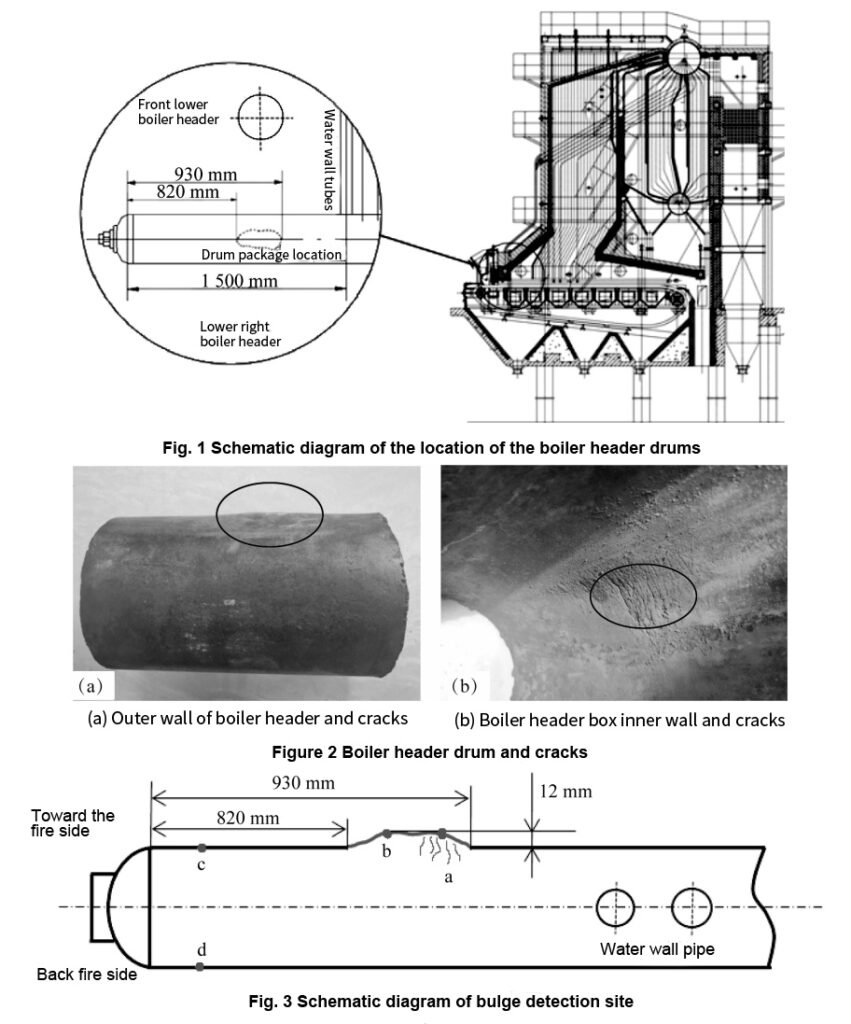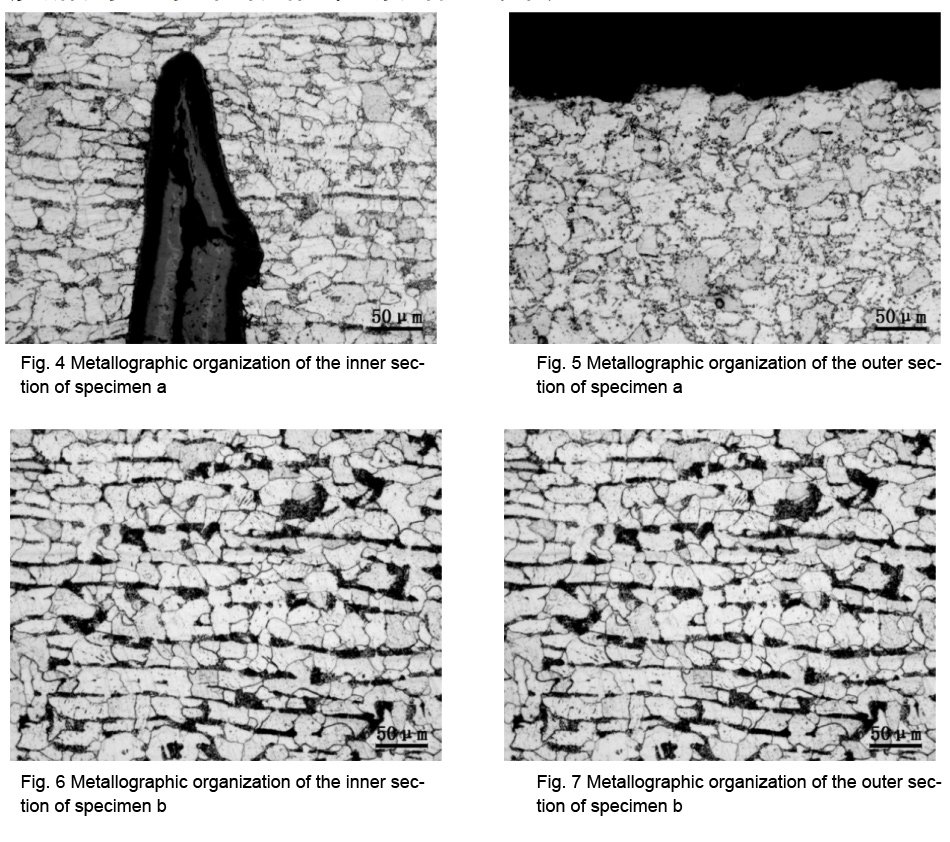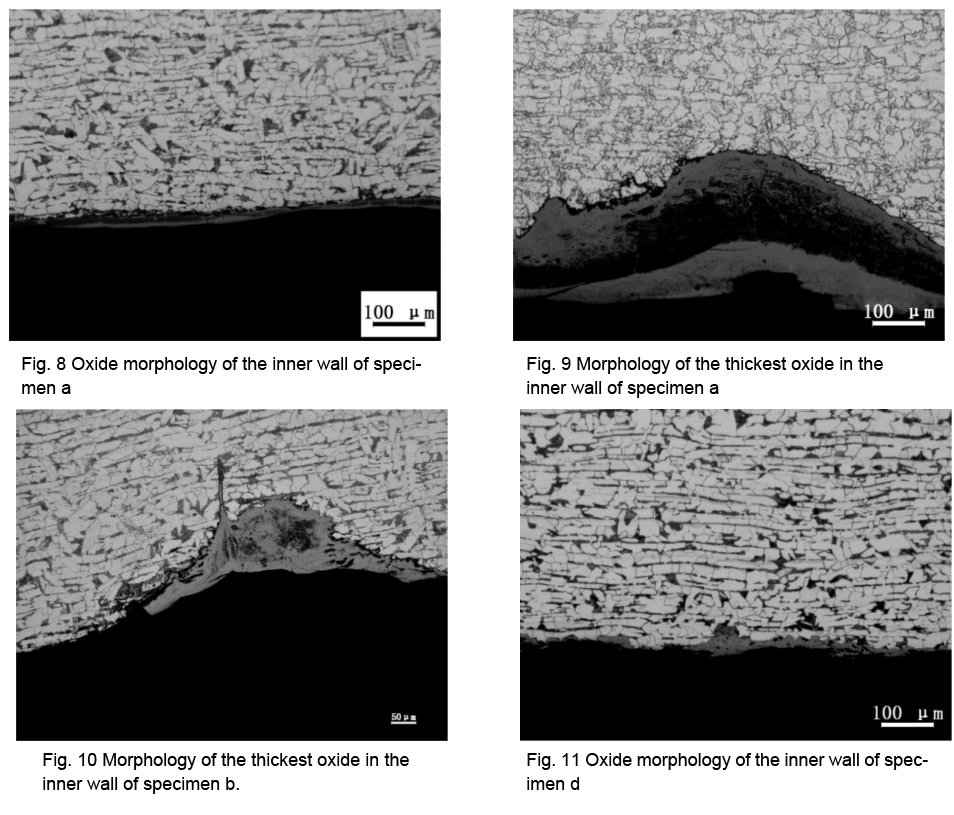I came across an interesting situation during our recent inspection of the SHL 10-16-A double-bottomed horizontal chain grate boiler. What caught our attention was a rather peculiar issue in the lower right boiler header box. There was a noticeable bulge, measuring about 110 mm × 60 mm and standing 12 mm tall, positioned between 820 mm to 930 mm away from the front of the box. You can see the exact location of this bulge in Fig. 1.
Upon delving into the technical specifications of the boiler, we discovered that the boiler header box was designed with dimensions of 219 mm × 8 mm, constructed using 20# steel. However, when we took a closer look by removing the header box, we were met with a concerning sight. The surface of the header box was riddled with extensive tortoise cracks, with the longest one stretching approximately 43 mm. This wasn’t just any crack; it was a severe penetrative crack. To give you a visual, Fig. 2 depicts the compromised state of the boiler header box.
Now, let’s delve deeper into our findings and their implications.

1. Analysis of the cause of boiler header drum
Let me provide you with an analysis of the cause behind the boiler header drum issue we encountered:
(1) Micro-analysis:
When we examine the situation on a micro level, we find that the steel of the boiler box has been subjected to prolonged exposure to high temperatures. Under such conditions, the grains within the steel start to grow continuously. As these grains expand to a certain extent, the bonds between them weaken, resulting in a reduction in the plasticity and strength of the steel. This particular phenomenon is known as “overheating.” Consequently, when the steel of the boiler box experiences a decrease in both plasticity and strength due to overheating, it becomes vulnerable to deformation, leading to bulging, and eventually, cracking under the internal pressure it is subjected to.
(2) Macro-analysis:
Taking a broader view, we observed that the operation of the stoker was not conducted in a standardized manner. This led to an abnormal advancement of the main combustion zone, causing localized damage to the coal gate plate and uneven distribution of the coal layer thickness. Consequently, the temperature of the flame on the right side of the hearth became significantly higher, and this intense heat directly radiated onto the right boiler header box. Additionally, the water circulation at the front of the right boiler header was found to be suboptimal. Under continuous exposure to high-temperature radiation, the water vapor generated at the water side of the boiler header could not be efficiently channeled away, resulting in reduced heat transfer efficiency and the onset of overheating in this particular section of the boiler header.
These combined factors contributed to the formation of bulges and cracks in the affected portion of the boiler header. Understanding these root causes is crucial for implementing effective corrective measures and ensuring the continued safe operation of our boiler system.

2 Material test
I’d like to share some insights from our material testing on the boiler header:
2.1 Hardness Analysis:
We conducted a hardness analysis on the boiler header, which is made of 20# steel. We focused on four testing points, labeled as a, b, c, and d, each representing different positions relative to the bulge and its surrounding areas, as illustrated in Figure 3.
- For specimens a and b, located at the failure position near the bulge, we tested hardness values at three points on the outer surface, 0.5 times the thickness of the specimen (denoted as ‘t’), and the inner surface.
- For specimens c and d, positioned away from the bulge and the fire side and back fire side of the bulge, we tested hardness values at five evenly spaced points from the outer surface to the inner surface.
The results of these hardness tests are summarized in Table 1. It’s important to note that the hardness values were found to be lower than the normal hardness range for the material, which typically falls between 160 and 199 HV. This indicated an abnormality in the overall wall thickness direction hardness for the failed part (a). In the case of sample b, the hardness value on the outer surface at 0.5 t was below the normal range, while the inner surface exhibited normal hardness values. Specimens c and d, which were positioned away from the bulge, showed hardness values within the normal range. These results clearly indicate that the hardness in the bulge area did not meet the material requirements.
2.2 Metallographic Analysis:
Based on the hardness test results, we conducted metallographic analysis on positions a and b, which exhibited abnormal hardness. We took samples from both the inner and outer sections, followed by grinding, polishing, and corrosion with 4% nitric acid alcohol. The results of the metallographic analysis are depicted in Figures 4 to 7.

Figure 4 to Figure 5 show that the inner section of specimen a consisted of spheroidized carburite with some lamellar pearlite, while the outer section exhibited spheroidized carburite distributed in ferrite grains, signifying pearlite spheroidization throughout the wall thickness direction. On the other hand, Figures 6 to 7 reveal that the inner cross-section of specimen b displayed flake pearlite with some spheroidized carburite, while the outer cross-section showed spheroidized carburite with a small amount of flake pearlite, indicating pearlite spheroidization mainly in the wall thickness direction. This spheroidization of pearlite in both specimens a and b suggests material overheating, with specimen a showing more severe signs compared to specimen b. Furthermore, it’s worth noting that the outer section experienced more material degradation than the inner section.

2.3 Thickness and Continuity Analysis of Inner Wall Oxides:
To understand the state of oxides on the inner wall, we measured the oxide thickness on metallographic specimens a, b, and d. The oxide morphology is displayed in Figures 8 to 11. Notably, the maximum thickness of oxides on the inner wall of specimen a was 280 μm, while specimen b exhibited a maximum oxide thickness of 150 μm. Specimen d, which had not failed, displayed a discontinuous oxide layer with a thickness of 58 μm.
The morphology of the oxides attached to the specimens, particularly the presence of fine pits on the boiler header’s surface, played a critical role. These pits were prone to forming oxide-enriched areas, as evident in Figures 9 and 10. This, coupled with the structural discontinuity of the oxide, increased susceptibility to cracking at these pits.
Understanding these material characteristics is essential for addressing the issues we’ve encountered with the boiler header, guiding us toward effective corrective measures for ensuring the continued safe operation of our boiler system.
In conclusion, our analysis has shed light on several key findings:
(1) Through the hardness tests, we discovered that position a exhibited overheating in the overall wall thickness direction, while position b experienced overheating in the non-overall wall thickness direction. It became evident that the hardness of the bulging area did not meet the necessary usage requirements.
(2) The metallographic analysis further revealed the presence of pearlitic spheroidization at the failure position, indicating the occurrence of overheating. Additionally, we observed that the material degradation in position a was more severe than that in position b. Moreover, the material degradation was more pronounced in the outer cross-section compared to the inner cross-section.
(3) The formation of oxide-enriched areas, primarily occurring in small pits on the boiler header’s surface, was identified as a significant factor. These areas experienced high temperature gradients due to the poor thermal conductivity of the oxide. Furthermore, the structural discontinuity of the oxide exacerbated the susceptibility to cracking at these pits. Over time, under the influence of internal pressure, the continuous extension and accumulation of fine cracks eventually led to macroscopic cracking and penetration.
(4) Inadequate water circulation in the front section of the boiler header had a dual effect. It reduced the efficiency of heat transfer, and the localized burn damage to the coal gate plate resulted in uneven coal distribution and elevated flame temperatures on one side. This, in turn, contributed to overheating in the front portion of the boiler header.
(5) Recommendations for external boiler inspection include paying close attention to the combustion chamber flame for any noticeable unevenness. Simultaneously, it’s crucial to inspect the coal gate plate and coal feed auxiliary equipment for proper functionality.
(6) During internal boiler inspections, inspectors should adhere to the standard inspection protocol while also focusing their attention on checking the boiler collector for deformations, leakages, and other conditions on the fire side.
In light of these findings, it is essential to implement measures addressing these identified issues to ensure the safe and efficient operation of our boiler system.
DHB Boiler
Discover The Superior Quality And Cutting-Edge Technology Of DHB Boilers. Explore Our Range Of Biomass Boilers, Waste Heat Boilers, And More. Take Your Industrial Operations To New Heights With DHB Boiler.








